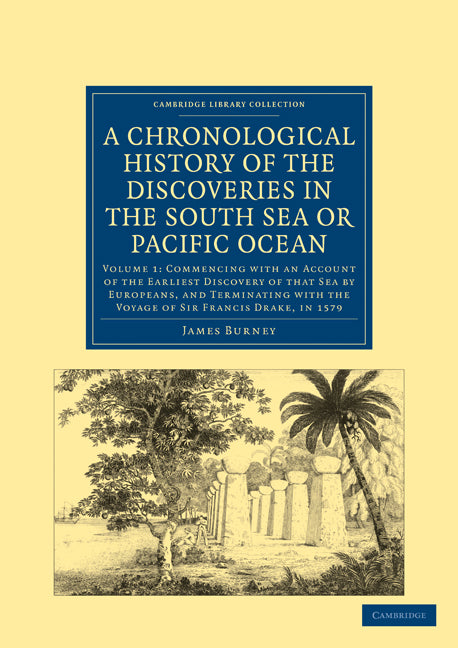Freshly Printed - allow 8 days lead
Couldn't load pickup availability
A Chronological History of the Discoveries in the South Sea or Pacific Ocean
Standard reference collection of summaries of European voyages of discovery between 1492 and 1764, first published between 1803 and 1817.
James Burney (Author)
9781108024082, Cambridge University Press
Paperback / softback, published 9 December 2010
438 pages, 5 maps
29.7 x 21 x 2.3 cm, 1.04 kg
Captain James Burney (1750–1821), the son of the musicologist Dr Charles Burney and brother of the novelist Fanny Burney, was a well-travelled sailor, best known for this monumental compilation of voyages of discovery in the Pacific Ocean. After joining the navy in 1764, he sailed on Cook's second voyage between 1772 and 1774, and was also present on the ill-fated third voyage. He retired from the navy in 1784 and turned to writing works on exploration. These volumes, published between 1803 and 1817, and regarded as the standard work on the subject for much of the nineteenth century, contain collected accounts of European voyages of discovery in the Pacific Ocean between 1492 and 1764. Burney provides summaries of contemporary Spanish, Dutch and English accounts, which include descriptions of voyages to China, Micronesia and Australia. Volume 1 covers voyages between 1492 and 1574, including the voyages of Magellan.
Dedication
1. Introductory
containing a brief account of the discoveries made in the South Sea, previous to the voyage of Magalhanes
2. Voyage of Fernando de Magalhanes
3. Sequel of the voyage after the death of Magalhanes
4. Progress of discovery on the western coast of America, to 1524. Disputes between the Spaniards and Portuguese, concerning the Spice Islands. Attempt to discover a Strait near the Isthmus of Darien
5. Voyage of Garcia Jofre de Loyasa, from Spain to the Moluccas. Discovery of the north coast of Papua, by the Portuguese. Voyage of Alvaro de Saavedra, from New Spain to the Moluccas
6. Various other expeditions between the years 1526 and 1533, each inclusive. Discoveries on the Western coast of America. Discovery of California
7. Expedition of Simon de Alcazova. The Spaniards penetrate to the South from Peru
8. The Marquis Del Valle sails to California. Voyage of Hernando de Grijalva, and Alvarado, from Peru to the Moluccas. Voyage of Alonzo de Camargo from Spain to Peru
9. Relation given by Marcos de Niza, of his journey to Cevola. Discovery by Franciso de Ulloa, that California was part of the Continent
10. Continuation of the discoveries to the North of Mexico. Expeditions of Hernando de Alarcon, and of Franciso Vasquez de Cornado
11. Schemes for maritime expeditions, formed by Pedro de Alvarado. They are frustrated by his death. Voyage of Juan Rodriguez Cabrillo, to the north of California. Establishment of the Spaniards in Chili. The coast of Japan seen for the first time by Europeans
12. Voyage of Ruy Lopez de Villalobos
13. Events connected with maritime expeditions in the South Sea, to the year 1558. Ships sent to examine the American coast to the south from Valdivia. Juan Ladrilleros to the Strait of Magalhanes
14. Expedition of Miguel Lopez de Legaspi, from New Spain to the Philippine Islands
15. Of the islands discovered near the continent of America in the Pacific Ocean
16. Discovery of the Salomon Islands, by Alvaro de Mendana
17. Progress of the Spaniards in the Philippine Islands. The islands San Felix and San Ambor discovered. Enterprise of John Oxnam, an Englishman, in the South Sea
18. Reports concerning the discovery of a southern continent
19. Voyage of Francis Drake round the world
20. Some account of the charts to this volume, with miscellaneous observations on the geography of the 16th century. Evidence in favour of the probability that the country, since named New Holland, was discovered by Europeans within that period
Appendix.
Subject Areas: History [HB]


